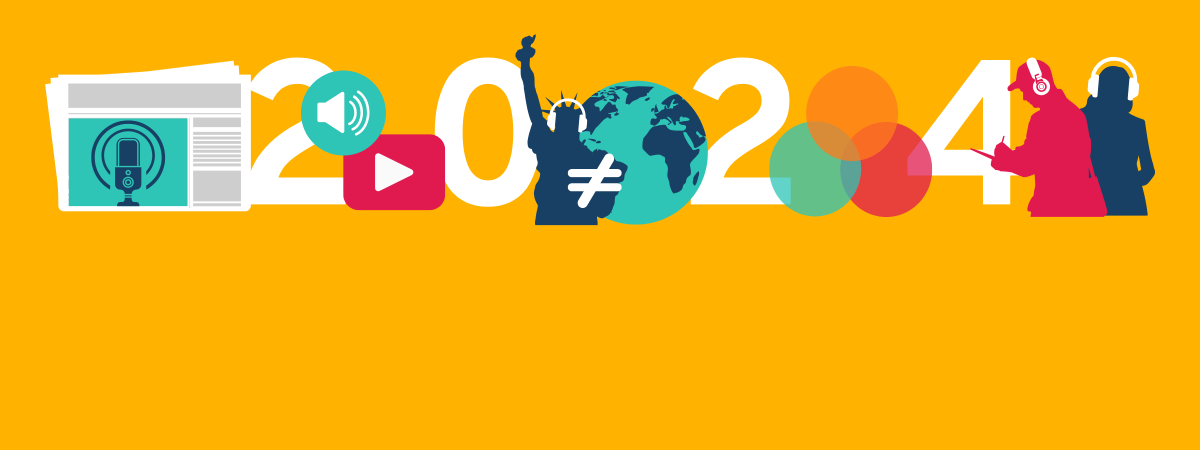2024 was a high water mark for Signal Hill Insights, working with our clients to survey a record of more than 65,000 audio listeners in the US, Canada, Australia and Netherlands. Of these, more than 70% listened to podcasts monthly.
About 80% of respondents participated in an audience landscape study like Sounds Profitable’s The Podcast Landscape, The Canadian Podcast Listener, The Cumulus Media / Signal Hill Insights Podcast Download, Radio on the Move, or Triton Digital Podcast Metrics Demos+. Landscape studies survey large, representative samples of a population with the goal of being able to draw reliable, generalizable conclusions.
A fifth of our respondents participated in brand lift and other advertising and branded content effectiveness studies. Each one is a smaller scale project that measures the impact of a specific ad campaign or a branded podcast. This year we grew the platforms of branded content we measure, adding video podcasts, social video on TikTok and Instagram Reels, and custom streaming music integrations.
Looking back at this wide and deep river of survey data, five things stand out.
1. Podcasts Are Mainstream
We learned that a majority of adults in the US and Canada have ever listened to a podcast: 57% in Canada (per The Canadian Podcast Listener) and 74% in the US. Overall American monthly podcast listenership has now crossed the half-way mark, totaling 53% of those 18 years or older, according to The Podcast Landscape. Moreover, the share is even higher among some multi-cultural groups, with more than 60% of Hispanic-American and Asian-American adults consuming podcasts monthly.
2. Podcasts are both Audio and Video (in the US and Canada)
Video became a sizzling hot – and controversial – topic for podcasting in 2024. Butt we first started tracking the rising trend back in July 2019, and confirmed its growth in the 2022 Spring Download which showed that more weekly podcast consumers in the US used YouTube more often than any other platform, including Spotify and Apple Podcasts. In 2024’s Fall Download YouTube assumed a surefooted lead, with 34% of weekly podcast consumers saying they use that platform most often, with Spotify coming in at #2.
This result is corroborated by the Q3 survey results from Triton’s Demos+. And the trend is nearly the same in Canada. YouTube claims the top spot north of the border, with 34% saying they use it most for podcasts. Spotify also lands in second place.
3. You Can’t Generalize US Findings to Other Countries
While YouTube now leads in the US and Canada, the Demos+ Australia survey shows that Spotify is still the most used podcast platform, with 40% of adult podcast consumers choosing it. This even outpaces YouTube’s share in both the US and Canada by six points. At the same time YouTube is most used by only 24% in Australia.
This is only one of the differences we observe in our international research showing the industry can’t just import from the US, even in regions that share a dominant language.
4. The Podcast Audience Is Not a Monolith
Leveraging Demos+ findings, in 2024 we published several blog posts looking at different audiences’ motivations for consuming podcasts. There are some consistencies – wanting to be entertained, to hear interesting stories, and learn new things top the list overall – though priorities shift for different audiences..
While standing apart from the overall podcast audience, we learned that there’s quite a bit of overlap between the motivations of senior business executives and black consumers. Both groups are more likely than others to say they listen to podcasts “for inspiration,” “for self-improvement,” and “to challenge the way they think.” Not surprisingly, these motivations also rank highly for business podcast consumers.
When we shift the focus to other genres, certain – sometimes obvious – priorities jump to the fore. Comedy consumers want to laugh and lift their mood, while newsies want “a deeper perspective on news and current events” and “to get a point of view I wouldn’t hear on other media.” Maybe less predictably, True Crime consumers value “keep(ing) my mind engaged while doing mindless tasks” and having “a mental escape” more than average.
This is valuable for producers to better grasp how podcasts fulfill the needs of specific audiences. For advertisers it informs creative development and planning, and where to find the right fit for products and messages.
5. Audio Listeners (and Survey Respondents) Are People, too
When you look at research, it’s easy to get mesmerized by all the numbers and overlook the fact that each and every datapoint comes from a real person. We’re measuring human responses – people telling us what media they consume, why and how they consume it, their opinions about what they consume, and the brands that support this content.
Most of our studies include open-ended questions, probing respondents to explain their answers, in their own words, grounding the data in personal experience. For instance, in a recent study for a branded video-first podcast one respondent said they liked it because, “the hosts were very bubbly and happy, and had great chemistry,” and another told us, “it felt professional and prepared, but not stiff.” Yet, even with high-performing content, not every review is five-star, as one respondent let us know, “I didn’t like to watch. They were just talking.”
This kind of direct feedback provides additional color and fills in the gaps to get a richer understanding of the data, while surfacing new insights for campaign optimizations or future studies..
We already have a slate of projects lined up for 2025, but there’s plenty of room for more. What would you like to learn about audio listeners this year? We’d love to hear from you.




